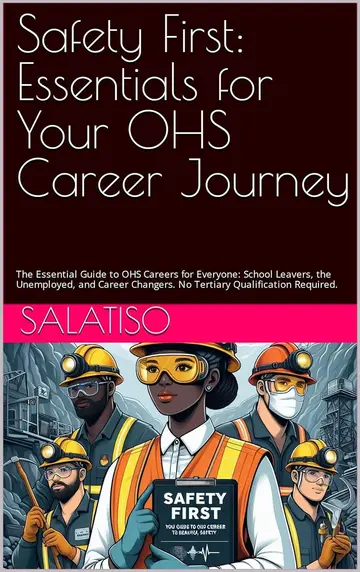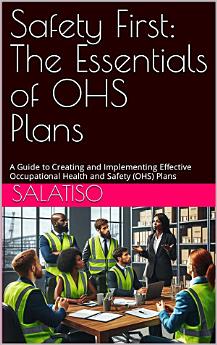Explore OHS Resources
This section provides access to essential OHS information including foundational legal frameworks, key regulations, standards, relevant organizations, and valuable learning materials to support your safety initiatives in South Africa.
The Constitution of South Africa, 1996
OHS Relevance: The supreme law providing the fundamental basis for OHS rights. Section 24 enshrines the right to an environment not harmful to health or well-being, and Section 27 guarantees access to healthcare, underpinning all OHS legislation.
Summary: The Constitution mandates the protection of health and well-being, which extends to the workplace. It forms the ethical and legal backbone for specialized OHS laws like OHSA and COIDA, ensuring that work environments do not compromise fundamental human rights to dignity, life, and security of person.
Occupational Health and Safety Act (OHSA), No. 85 of 1993
OHS Relevance: Principal legislation for health and safety in most SA workplaces (excluding mines). Mandates employer duties for a safe environment and employee responsibilities.
Summary: OHSA aims to protect all persons at work from hazards. Key provisions include employer duties (risk assessments, training, safe equipment - Section 8), employee duties (Section 14), H&S Reps/Committees (Sections 17-20), incident reporting (Section 24), and CEO accountability (Section 16). It operates on the principle of "reasonably practicable".
Compensation for Occupational Injuries and Diseases Act (COIDA), No. 130 of 1993
OHS Relevance: Establishes a no-fault compensation system for employees injured or who contract diseases at work.
Summary: COIDA provides financial compensation and medical benefits via the Compensation Fund. Employers register and pay assessments. It generally limits civil liability of employers for occupational injuries/diseases (Section 35).
Mine Health and Safety Act (MHSA), No. 29 of 1996
OHS Relevance: Specific legislation for the high-risk mining industry, addressing its unique hazards.
Summary: MHSA aims to protect all persons at mines. It mandates risk assessments, Codes of Practice (CoPs), tripartite participation, and gives employees the right to refuse dangerous work.
Primary Acts are supported by specific regulations. Always consult the Department of Employment and Labour (DoEL) or Department of Mineral Resources and Energy (DMRE) for the latest versions.
OHSA Regulations:
General Administrative Regulations (GAR)
OHS Relevance: Detail administrative procedures for OHSA, including H&S committee functions, incident reporting (WCL forms), and investigations.
Summary: GAR provides the "how-to" for many OHSA administrative requirements, ensuring consistent processes for inspector access, H&S representative nominations, and incident management documentation.
General Safety Regulations (GSR)
OHS Relevance: Cover a wide range of general workplace safety issues like PPE, first aid, ladder safety, housekeeping, and fire precautions.
Summary: GSR sets baseline safety standards for common workplace hazards, ensuring fundamental protective measures are in place.
Construction Regulations
OHS Relevance: Critical for the high-risk construction sector. Detail duties for clients, designers, contractors; requirements for permits, safety files, risk assessments, and competent person appointments (e.g., CHS Officer).
Summary: These regulations aim to manage complex safety risks on construction sites through structured planning, clear responsibilities, and specific controls for high-risk activities like excavation and working at height.
Ergonomics Regulations, 2019
OHS Relevance: Address risks from poor ergonomic design, aiming to prevent musculoskeletal disorders.
Summary: These regulations require employers to proactively manage ergonomic hazards to ensure tasks, equipment, and workstations are designed to fit the worker, reducing strain and injury.
Noise Exposure Regulations, 2024
OHS Relevance: Protect against noise-induced hearing loss by setting limits, requiring assessments and controls.
Summary: These regulations mandate a comprehensive hearing conservation program where noise levels are hazardous, including a Code of Practice for Audiometry.
Other important OHSA regulations include: Hazardous Chemical Substances, Driven Machinery, Electrical Machinery, Electrical Installation, Facilities, and Draft Lead Regulations. Find these on the DoEL website.
National Building Regulations & SANS Standards:
National Building Regulations and Building Standards Act (NBRBSA)
OHS Relevance: Ensures safety of physical structures (workplaces) by prescribing minimum building standards.
Summary: NBRBSA compliance is fundamental to an employer's duty under OHSA Section 8 to provide a safe working environment.
SANS 10400 & SANS/ISO 45001
OHS Relevance: SANS 10400 provides technical specs for NBRBSA compliance. SANS/ISO 45001 is the national standard for OHS management systems.
Summary: SANS 10400 details how to meet building regulations (e.g., Part T for Fire Protection). SANS/ISO 45001 offers a framework for organizations to systematically manage OHS risks and improve performance.
MHSA Regulations:
Extensive, chapter-based regulations specific to mining hazards (e.g., machinery, explosives, rescue). Access via DMRE.
Basic Conditions of Employment Act (BCEA)
OHS Relevance: Regulates working hours, leave, and night work, crucial for preventing fatigue.
Summary: Provisions on maximum working hours, rest periods, and leave support OHS by promoting worker well-being.
Labour Relations Act (LRA)
OHS Relevance: Framework for dispute resolution (CCMA, Labour Court) that can address OHS grievances.
Summary: The LRA empowers employees to assert OHS rights (e.g., refusing unsafe work) without fear of unfair dismissal.
Other relevant acts include NEMA, Hazardous Substances Act, National Water Act, Fire Brigade Services Act, Disaster Management Act, National Health Act. Find these on www.gov.za/documents.
DoEL Directives (e.g., COVID-19 Directions)
OHS Relevance: Specific instructions from the Department of Employment and Labour for emerging OHS issues.
Summary: COVID-19 directives mandated risk assessments, controls (ventilation, PPE), screening, etc. Always check DoEL website for current directives.
National Department of Health (NDoH) OHS Policy
OHS Relevance: An example of a comprehensive OHS policy for a large government department.
Summary: This policy outlines how the NDoH manages OHS, drawing on the Constitution, OHSA, COIDA, etc. It serves as a model for public sector OHS management.
International Guidelines (ILO, ISO 45001)
OHS Relevance: Influence SA practices. ILO Conventions provide frameworks. ISO 45001 is the global standard for OHS management systems.
Summary: Adherence to international guidelines like ISO 45001 helps organizations align with global best practices and improve OHS performance systematically.
Municipal bylaws address local OHS conditions (public health, building control, fire services). Businesses must comply with national laws and local bylaws.
Finding Local Bylaws
Consult your specific local municipality's website or use databases like Sabinet.
Examples: City of Johannesburg Public Health By-laws (sanitation, offensive trades), City of Cape Town (NBR enforcement, Events By-law), eThekwini (Public Health By-law). Check respective municipal websites.
Court judgments interpret OHS laws and influence their application. Case law is dynamic.
Truworths v Chief Inspector (ZALCJHB 108, 2025)
OHS Relevance: Addressed inspector designation (Sec 28 OHSA), "reasonably practicable" for facilities (seating), and appeal processes.
Outcome: Appeal upheld due to lack of proof of inspector certification and misapplication of "reasonably practicable". Highlights importance of procedural correctness by regulators.
Mahlangu v Minister of Mineral Resources (ZALMPPHC 72, 2025)
OHS Relevance: Dealt with applicability of COIDA (Sec 35 precluding civil action) vs. delictual claims, and OHSA vs. MHSA for mines.
Outcome: Exception to plaintiff's claim upheld. Emphasizes correct identification of legislative framework for workplace injury claims.
Finding More Case Law
The Southern African Legal Information Institute (SAFLII) is a primary free resource.
Department of Employment and Labour (DoEL)
Enforces OHSA, conducts inspections, develops policy.
Department of Mineral Resources and Energy (DMRE)
Enforces MHSA for the mining sector.
National Institute for Occupational Health (NIOH)
Conducts research, provides specialized services, training.
South African Bureau of Standards (SABS)
Develops SANS standards (e.g., SANS 10400, SANS/ISO 45001).
South African Council for Project and Construction Management Professions (SACPCMP)
Statutory body registering Construction Health and Safety Professionals.
Southern African Institute for Occupational Hygiene (SAIOH)
Professional body for occupational hygienists.
South African Institute of Occupational Safety and Health (SAIOSH)
Largest OHS professional body in Africa.
Master Builders South Africa (MBSA)
Represents employers in construction, provides OHS support.
SafetyHelp Platform Resources
Access OHS document templates (appointment letters, risk assessments, H&S plans), internal data files, and book chapter HTMLs.
Templates are available on the SafetyHelp platform.
Government & Official Body Resources
DoEL reports, NDoH OHS policy examples, NIOH research, DMRE mining guidelines.
Other Free Templates & Guides
Platforms like Genie AI and PDFFiller offer various SA-compliant safety plan templates. Always verify suitability.

Safety First: The Comprehensive Blueprint for Your OHS Career
A pivotal guide for aspiring and established OHS professionals, offering a streamlined path to a fulfilling career.
View on Google Play- Introduction: Why OHS Matters
- Part 1: Evolution of OHS (Ch 1-4)
- Part 2: Getting Started (Ch 5-9)

Safety First: The Essentials of OHS Plans
Essential knowledge and tools to establish a safe and healthy workplace, focusing on robust OHS plan creation.
View on Google Play- Ch 1: Understanding OHS Plans
- Ch 2: Legal Framework & Compliance